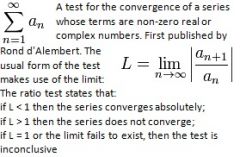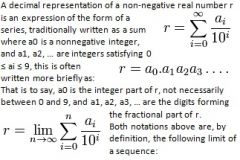![]()
![]()
![]()
Use LEFT and RIGHT arrow keys to navigate between flashcards;
Use UP and DOWN arrow keys to flip the card;
H to show hint;
A reads text to speech;
10 Cards in this Set
- Front
- Back
|
Ratio
|
A ratio is an expression that compares quantities relative to each other.
|
|
|
Ratio Test
|

|
|
|
Cylinder
|
A cylinder is one of the most basic curvilinear geometric shapes, the surface formed by the points at a fixed distance from a given line segment, the axis of the cylinder. The solid enclosed by this surface and by two planes perpendicular to the axis is also called a cylinder. The surface area and the volume of a cylinder have been known since deep antiquity.
|
|
|
Decimal Representation
|

|
|
|
Interval
|
In mathematics, a (real) interval is a set of real numbers with the property that any number that lies between two numbers in the set is also included in the set. For example, the set of all numbers x satisfying 0 ≤ x ≤ 1 is an interval which contains 0 and 1, as well as all numbers between them. Other examples of intervals are the set of all real numbers ℝ, the set of all negative real numbers, and the empty set.
|
|
|
Irrational Numbers
|
In mathematics, an irrational number is any real number that cannot be expressed as a ratio a/b, where a and b are integers, with b non-zero, and is therefore not a rational number. Informally, this means that an irrational number cannot be represented as a simple fraction. Irrational numbers are those real numbers that cannot be represented as terminating or repeating decimals.
|
|
|
Rational Numbers
|
In mathematics, a rational number is any number that can be expressed as the quotient or fraction p/q of two integers, with the denominator q not equal to zero. Since q may be equal to 1, every integer is a rational number. The set of all rational numbers is usually denoted by a boldface Q (for "quotient").
|
|
|
Real Number
|
In mathematics, a real number is a value that represents a quantity along a continuous line. The real numbers include all the rational numbers, such as the integer −5 and the fraction 4/3, and all the irrational numbers such as √2 (1.41421356... the square root of two, an irrational algebraic number) and π (3.14159265..., a transcendental number). Real numbers can be thought of as points on an infinitely long line called the number line or real line, where the points corresponding to integers are equally spaced. Any real number can be determined by a possibly infinite decimal representation such as that of 8.632, where each consecutive digit is measured in units one tenth the size of the previous one.
|
|
|
Whole Number
|
The integers are formed by the natural numbers (including 0) (0, 1, 2, 3, ...) together with the negatives of the non-zero natural numbers (−1, −2, −3, ...). Viewed as a subset of the real numbers, they are numbers that can be written without a fractional or decimal component, and fall within the set {..., −2, −1, 0, 1, 2, ...}. For example, 21, 4, and −2048 are integers; 9.75, 5½, and √2 are not integers. The set of all integers is often denoted by a boldface Z.
|
|
|
Inequality
|
In mathematics, an inequality is a statement about the relative size or order of two objects.
|

